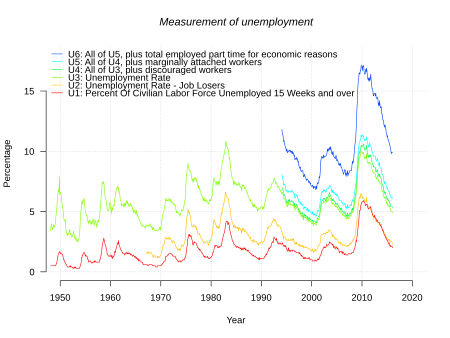Bureau of Labor Statistics
The Bureau of Labor Statistics (BLS) is a unit of the United States Department of Labor. It is the principal fact-finding agency for the U.S. government in the broad field of labor economics and statistics and serves as a principal agency of the U.S. Federal Statistical System. The BLS is a governmental statistical agency that collects, processes, analyzes, and disseminates essential statistical data to the American public, the U.S. Congress, other Federal agencies, State and local governments, business, and labor representatives. The BLS also serves as a statistical resource to the United States Department of Labor, and conducts research into how much families need to earn to be able to enjoy a decent standard of living.[4]
 | |
| Agency overview | |
|---|---|
| Formed | June 27, 1884 |
| Jurisdiction | Federal government of the United States |
| Headquarters | Postal Square Building Washington, D.C., U.S. |
| Employees | 2,500[1] |
| Annual budget | $609 million[2] |
| Agency executives |
|
| Website | www |
The BLS data must satisfy a number of criteria, including relevance to current social and economic issues, timeliness in reflecting today's rapidly changing economic conditions, accuracy and consistently high statistical quality, impartiality in both subject matter and presentation, and accessibility to all. To avoid the appearance of partiality, the dates of major data releases are scheduled more than a year in advance, in coordination with the Office of Management and Budget.[5]
History
The Bureau of Labor was established in the Department of the Interior by the Bureau of Labor Act (23 Stat. 60), June 27, 1884, to collect information about employment and labor. It followed the hearings led by Henry W. Blair of the Committee of the Senate upon the relations between Labor and Capital.[6] Carroll D. Wright was the first U.S. Commissioner of Labor. It became an independent (sub-Cabinet) department by the Department of Labor Act (25 Stat. 182), June 13, 1888. It was incorporated, as the Bureau of Labor, into the Department of Commerce and Labor by the Department of Commerce Act (32 Stat. 827), February 14, 1903. Finally, it was transferred to the Department of Labor in 1913 where it resides today.[7][8] The BLS is now headquartered in the Postal Square Building near the United States Capitol and Union Station.
Since 1915, the BLS has published a journal, the Monthly Labor Review, with articles about the data and methodologies of labor statistics.
The BLS is headed by a commissioner who serves a four-year term from the date he or she takes office. The most recent Commissioner of Labor Statistics is William W. Beach[9], who was assumed office on March 28, 2019 [10][11] Dr. William Beach was confirmed by the United States Senate on March 13, 2019. William Beach's Senate Confirmation.
Erica Groshen, who was confirmed by the U.S. Senate on January 2, 2013 and sworn in as the 14th Commissioner of Labor Statistics on January 29, 2013, for a term that ended on January 27, 2017.[12][13] William Wiatrowski, Deputy Commissioner of the BLS, was serving as Acting Commissioner until the next commissioner, William Beach was sworn in.
Statistical reporting
Statistics published by the BLS fall into four main categories:[14]
Prices
- U.S. Consumer Price Index
- Producer Price Index
- U.S. Import and Export Price Indices
- Consumer Expenditure Survey
Employment and unemployment

- Current Population Survey (The "Household Survey")
- Current Employment Statistics[16] (The "Establishment Survey")
- Local Area Unemployment Statistics (LAUS)[17]
- List of U.S. states by unemployment rate
- Current Employment Statistics State and Area program[18]
- The Job Openings and Labor Turnover Survey (JOLTS)[19]
- The Quarterly Census of Employment and Wages (QCEW)[20]
- The Business Employment Dynamics (BED) program[21]
- Ten year occupational employment projections
- Occupational Employment Statistics (OES)
- Mass Layoff Statistics--discontinued in 2013[22]
Compensation and working conditions
- National Compensation Survey
- Employment Cost Index
- Workplace Injury and Fatality Statistics[23]
Productivity
- Labor productivity, aggregate and by industry[24]
- Multifactor productivity
Statistical regions
Data produced by the BLS is often categorized into groups of states known as Census Regions. There are 4 Census Regions, which are further categorized by Census Division as follows:
Northeast Region
- New England Division: Connecticut, Maine, Massachusetts, New Hampshire, Rhode Island, and Vermont.
- Middle Atlantic Division: New Jersey, New York, and Pennsylvania.
South Region
- South Atlantic Division: Delaware, District of Columbia, Florida, Georgia, Maryland, North Carolina, South Carolina, Virginia, and West Virginia.
- East South Central Division: Alabama, Kentucky, Mississippi, and Tennessee.
- West South Central Division: Arkansas, Louisiana, Oklahoma, and Texas.
Midwest Region
- East North Central Division: Illinois, Indiana, Michigan, Ohio, and Wisconsin.
- West North Central Division: Iowa, Kansas, Minnesota, Missouri, Nebraska, North Dakota, and South Dakota.
West Region
- Mountain Division: Arizona, Colorado, Idaho, Montana, Nevada, New Mexico, Utah, and Wyoming.
- Pacific Division: Alaska, California, Hawaii, Oregon, and Washington.
See also
- Alternative employment arrangements
- Bureau of Economic Analysis
- Career Guide to Industries
- Data.gov
- Economic reports
- Index of Leading Indicators
- Job Creation Index
- Monthly Labor Review
- National Income and Product Accounts
- Occupational Outlook Handbook
- U.S. Census Bureau
- USAFacts
Footnotes
- "What BLS Does". Bureau of Labor Statistics. February 9, 2009. Archived from the original on May 8, 2011. Retrieved May 10, 2011.
- "BLS 2016 Operating Plan" (PDF). US Department of Labor. Archived from the original on 2017-03-01. Retrieved 2017-02-22.
- "Bureau of Labor Statistics: Senior Staff". Bureau of Labor Statistics. 2017-01-30. Archived from the original on 2017-02-23. Retrieved 2017-02-22.
- "Archived copy" (PDF). Archived (PDF) from the original on 2014-06-11. Retrieved 2013-12-22.CS1 maint: archived copy as title (link)
- Cohen, Patricia (2016-11-03). "How Economic Data Is Kept Politics-Free". The New York Times. ISSN 0362-4331. Archived from the original on 2017-03-11. Retrieved 2017-02-23.
- GB McKinney, Henry W. Blair’s Campaign to Reform America: From the Civil War to the U.S (2012) 110-111
- "Records of the Bureau of Labor Statistics [BLS]". National Archives. 2016-08-15. Archived from the original on 2017-02-24. Retrieved 2017-02-23.
- "Overview : U.S. Bureau of Labor Statistics". www.bls.gov. Archived from the original on 2017-02-23. Retrieved 2017-02-23.
- https://www.bls.gov/bls/senior_staff/beach.htm
- President Donald J. Trump Announces Key Additions to his Administration, whitehouse.gov, 17 Oct 2017
- Nomination - William Beach — Department of Labor, 16 Jan 2019
- Presidential Nominations, 112th Congress (011 - 2012), PN1404-112 Archived 2016-01-02 at the Wayback Machine, Library of Congress, thomas.loc.gov
- Senate Confirms Erica Groshen to Head Bureau of Labor Statistics Archived 2017-09-04 at the Wayback Machine, by Jeffrey Sparshott at Wall Street Journal]
- "Archived copy". Archived from the original on 2017-02-23. Retrieved 2017-02-23.CS1 maint: archived copy as title (link)
- "American Time Use Survey". Bureau of Labor Statistics. Archived from the original on 2017-02-23.
- "Current Employment Statistics". Bureau of Labor Statistics. Archived from the original on 2017-02-23.
- "Local Area Unemployment Statistics". Bureau of Labor Statistics. Archived from the original on 2017-09-08.
- "Employment, Hours, and Earnings from the Current Employment Statistics survey (State & Metro Area) Home Page". Bls.gov. 2012-05-30. Archived from the original on 2012-06-15. Retrieved 2012-06-22.
- "Job Openings and Labor Turnover Survey Home Page". Bls.gov. Archived from the original on 2012-06-16. Retrieved 2012-06-22.
- "Quarterly Census of Employment and Wages". Bls.gov. 2012-03-28. Archived from the original on 2012-06-10. Retrieved 2012-06-22.
- "Business Employment Dynamics Home Page". Bls.gov. 2012-05-01. Archived from the original on 2012-10-15. Retrieved 2012-06-22.
- "Mass Layoff Statistics Home Page". Bls.gov. 2012-05-16. Archived from the original on 2017-02-23. Retrieved 2017-02-22.
- "Injuries, Illnesses, and Fatalities". Bls.gov. Archived from the original on 2012-06-26. Retrieved 2012-06-22.
- "Overview of BLS Productivity Statistics". Bls.gov. Archived from the original on 2012-06-25. Retrieved 2012-06-22.
Further reading
- Joseph P. Goldberg and William T. Moye, The First 100 Years of the Bureau of Labor Statistics. Bulletin No. 2235. Washington, D.C.: U.S. Government Printing Office, 1985.
- William J. Wiatrowski, "BLS at 125: Using historic principles to track the 21st-century economy". Monthly Labor Review, June 2009, pp. 3–25.
External links
| Wikimedia Commons has media related to Bureau of Labor Statistics. |
- Official website
- Records of the Bureau of Labor Statistics in the National Archives (Record Group 257)
- Bureau of Labor Statistics in the Federal Register
- Publications of the BLS available on FRASER
- Bulletins of the United States Bureau of Labor Statistics, dating back to 1895
- Local Area Unemployment Reports
